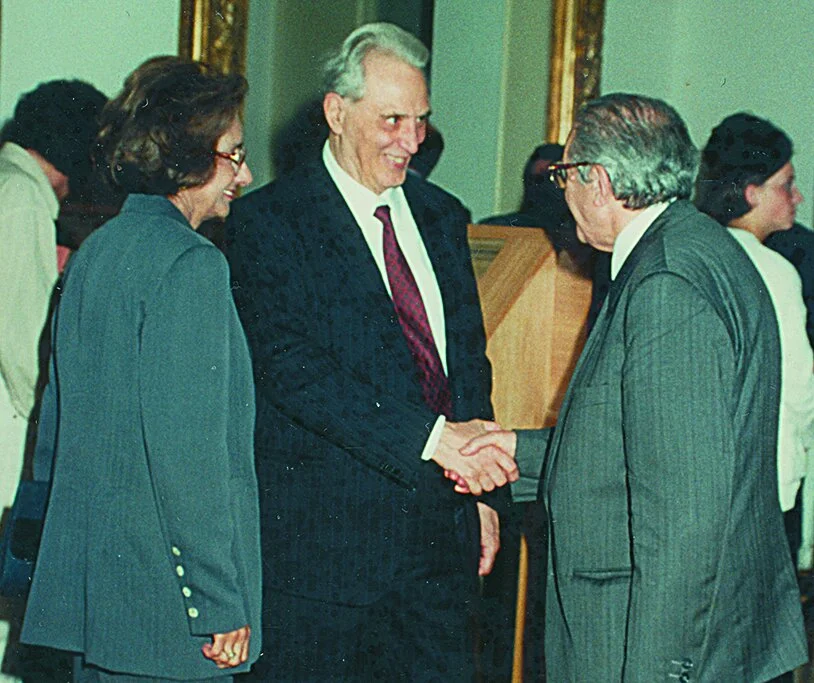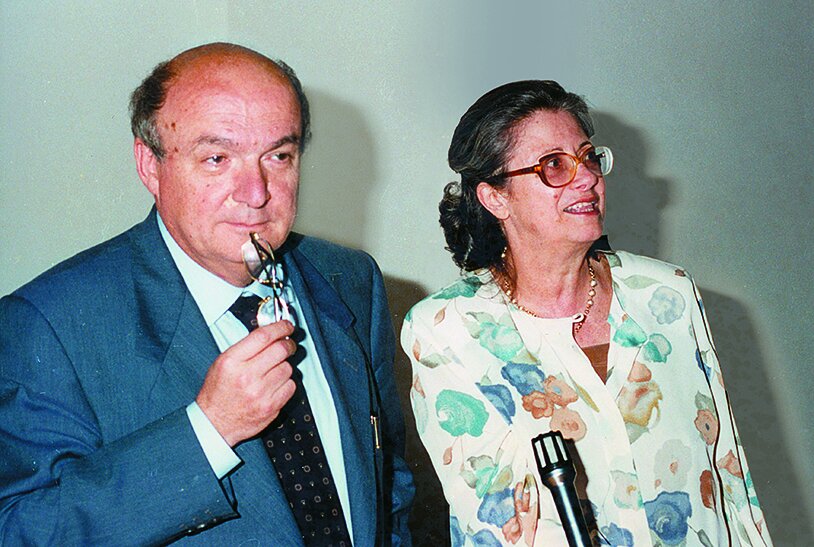Evolution of a Museum: An Interview with Francesco di Gennaro
The Museo Nazionale d’Arte Orientale ‘Giuseppe Tucci’ (MNAO) in Rome was established in 1957 and opened to the public in 1958. With a focus on Asian art, its existence can be largely attributed to the work of the scholar and explorer Giuseppe Tucci (1894−1984), to whom the museum was dedicated in 2005. Leading us into this dedicated issue, Director Soprintendente Francesco di Gennaro spoke to Orientations to illuminate the founding principles and the ongoing work of this institution.
Orientations Director di Gennaro, what were the founding aims of the MNAO, and have those aims changed at all since its inception?
Francesco di Gennaro The museum has expanded considerably since its founding more than half a century ago. Its aims were clearly described in the Decree of the President of the Republic, no. 1410 of 3 October 1957—to continue the long tradition of Italian research and study into Asian art and culture—and it provides an appropriate home for Asian art collected by the Istituto Italiano per il Medio ed Estremo Oriente [IsMEO, later IsIAO]. In addition, since 1964 the museum has served as a repository for excavated materials from archaeological missions in Iran, Afghanistan and Pakistan. Over the years, many more objects and collections from diverse regions have augmented the collections, through donation and purchase.
Today the museum is experienced not only as an exhibition space , but as a sequence of metaphorical windows opening onto various research projects. This perspective is possible thanks to our team of highly skilled specialists working behind the scenes to facilitate foreign missions, research and exhibitions. In my opinion, the most important thing to be understood is that this museum is really a bridge to East Asia, and serves as a kind of diplomatic portal, worthy of expansion, for Italians and for foreign communities and visitors to Rome.
Francesco di Gennaro
O Can you tell readers about the background to the museum’s dedication to Giuseppe Tucci? What was Tucci’s greatest contribution to the museum?
FdG The dedication is particularly appropriate because the museum itself was established thanks to Tucci’s work. He chaired IsMEO from 1947 to 1978, and one of his goals was to establish a public institution that would serve as a point of reference for Asian art in Italy, as well as a fitting space for exhibition and conservation.
Within the large scope of Tucci’s contributions to the museum, it is impossible to single one out. However, in terms of cultural weight, the presence of the sculptures and reliefs from Gandhara in Pakistan, which were assigned to Italy after the excavations began in 1956, was historically crucial and this large collection remains pre-eminent. The Himalayan section is also of exceptional importance.
O How many visitors does the museum receive each year? Which areas of Asian art are of particular interest to Italian museumgoers at present?
FdG When compared to some other museums in the capital, the MNAO has relatively fewer visitors on a daily basis. There are two reasons for this: first, the wealth of opportunities offered by Rome, revolving mainly, of course, around the art and archaeology of Italy; and second, the contraction of the economy, the effects of which fall both on the number of visitors and the museum’s activities.
However, the significant increase in visitors during special events and exhibitions reminds us that Italy is a country that has always had close ties with Asia. Today the interest of the Italian population, which includes a growing number of Asian communities, seems to be more focused on the Islamic world and on East Asia.
Comb
Iran, Sistan-Baluchistan, Shahr-i-Sokhta, 3rd millennium BCE
Wood
Maximum height 3.7 cm
O What specific initiatives is the museum undertaking to promote Asian art?
FdG The museum operates several initiatives aimed not only at preserving, studying and exhibiting materials, but also at advancing ties between Italy and the countries of Asia. There have been a number of important international exhibitions that illustrate both little-known aspects of Asian art and renowned artefacts from Asian museums. To name just a few, in 2001 we held the exhibition ‘Ancient Persia: The Treasures of the Tehran National Museum and the Italian Research in Iran’ with the National Museum of Tehran and the Embassy of the Islamic Republic of Iran. ‘The Treasures of the Tianjin Art Museum’ in 2005 was coorganized with the municipality of Tianjin, China. Among other noteworthy exhibitions were: in 2009, ‘The Lure of Green: Continuity and Innovation in the Celadons of Ganjin City’ with the municipality of Ganjin, Republic of Korea; ‘The Throne of the Queen of Sheba’ (2012) with the Yemen Embassy in Italy; and ‘Master Craftsmen of Korea: Masterpieces from Seoul’ (2013) with the Association of Intangible Cultural Heritage, Seoul.
The museum organizes conferences, lecture series, performances, shows and concerts. It also offers training courses on specific aspects of Asian cultures for teachers of all levels in collaboration with the municipality of Rome and the universities.
O What about exchange or joint research programmes with other institutions?
FdG Over the years, the museum has participated in and promoted numerous joint research programmes; for example, with the National Institute for Cultural Properties of Tokyo regarding works of art on paper; and with the Austrian Academy of Science and the Austrian Science Fund regarding the Tucci Photographic Archive and the Tucci Tibetan paintings collection. The museum has also benefited from the Library Support Program of the Japan Foundation, which has contributed to our library about fifty important, recently published volumes on Japanese culture and art.
Relief showing a scene from Jataka (stories from the previous lives of the Buddha)
Pakistan, Swat valley, 2nd century
Schist
Height 19 cm
(Italian Archaeological Mission Excavations)
O Earlier you mentioned the materials excavated in Iran, Afghanistan and Pakistan by archaeological missions since the middle of the last century. What, in your view, are the strengths of some of these collections? How has research on such objects helped enrich scholarship in this field?
FdG Over the past decades, the museum’s collections have increased in importance: today it is very difficult to export from their countries of origin objects of such high art-historical value. The sculptures of Gandhara are the most significant part of a collection of the art of Pakistan, the largest one in the West. Thus they provide rich material for comparative art-historical studies on both iconographic and narrative aspects, as well as on manufacturing techniques. The materials from Ghazni in Afghanistan, including the marble funerary inscriptions, have allowed scholars to reach important conclusions not only with regard to the official protocols used by the Ghaznavids [975-1186] and Ghuridi sovereigns [1149-1215], but also on the evolution of monumental inscriptions in the eastern Islamic lands.
Prehistoric material from Shahr-i Sokhta in Baluchistan, Iran offers a great sampling of complete objects, as well as scraps and fragments, allowing for the advancement of knowledge for both established scholars and university students.
O Please tell us about some objects, or groups of objects, that have particular significance for you.
FdG Several wooden combs came from the excavations at Shahr-i-Sokhta, Sistan-Baluchistan, in Iran, preserved thanks to the favourable conditions of the strata. In some cases, the woods originate from as far away as the Indian subcontinent, attesting long-distance trade in the 3rd millennium BCE. We cannot exclude the possibility that they were used for combing the hair, but it is more likely that such combs with thick prongs would serve to tighten the mesh of fabrics during weaving.
The other object I wish to discuss is one of the reliefs from the Gandhara group, in characteristic grey stone. This work clearly illustrates the meeting of Eastern traditions and iconographic classical Mediterranean schemes that was systematically studied by Domenico Faccenna for about 50 years. In this work, for example, we can observe the events of the Buddha’s life set in a context of Hellenistic architecture.
Domenico Faccenna (centre), the first director of the MNAO (1958–77)
O You joined the MNAO as director in February 2012. What do you hope to achieve during your tenure? What about your longer-term vision for the museum?
FdG Although I have been director for only about two years, my medium-term outlook for the museum is clear. What is less clear is whether these objectives will be achieved due to present financial limitations.
First, it is necessary to increase the rate of research activities, both through fieldwork and desk research. For this purpose, additional researchers including senior scientists are necessary. One important goal is a new, state-owned museum building, with more rationally apportioned areas that would increase and diversify the exhibition space, allowing for the display of art from additional regions of Asia; there would also be a better integration of services, and adequate space for conferences, workshops and meetings. This would enable the museum to better fulfil its function as a meeting place of diverse cultures. Moreover, the museum’s traditional home in the Palazzo Brancaccio (rented space in a shared building with diverse functions) forces its coexistence with a vessel whose own worthy characteristics detract from the museum’s objectives. And thus a situation arises whereby the focus is on its own internal history rather than the museum’s scientific objectives.
O What does the scholarship and legacy of Giuseppe Tucci mean to you, as director? What aspects of this legacy do you hope will endure?
FdG One important aspect of Tucci’s legacy is as a reminder of the development by Italian scholars of a more accurate classification and chronological sequence for the materials and for the historical development of areas about which, in some cases, nothing was previously known. Among Tucci’s gifts, I would include the very existence of this institution and the high standards he set for it—standards upheld since the institution’s foundation by the great directors and orientalist-archaeologists Domenico Faccenna and Donatella Mazzeo. More recently, the direction of the museum has been entrusted to non-Asian art specialists and, moreover, only for short periods; my own research perspective has not previously gone beyond the Mediterranean area. In honour of Giuseppe Tucci and of the important and evolving mission of this museum, I believe it is vital for its future direction that the ministry would provide a way to reserve its direction for Asian and archaeology specialists.
All images are © Museo Nazionale d’Arte Orientale ‘Giuseppe Tucci’.
Former MNAO director (1977–78 and 1980–2005) Donatella Mazzeo (right) with Antonio Paolucci, Ministry of Italian Cultural Heritage and now Director of the Vatican Museums





